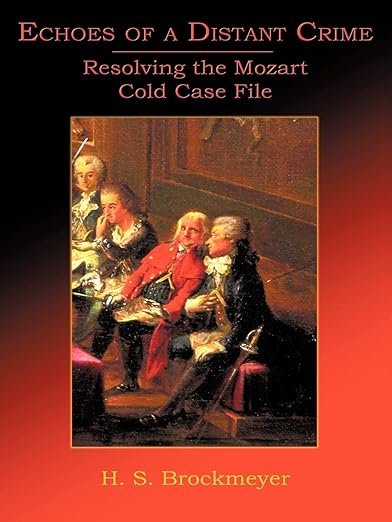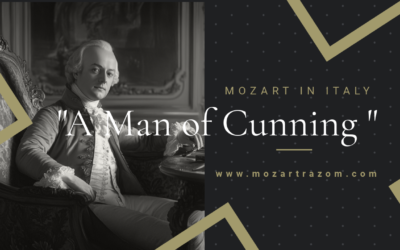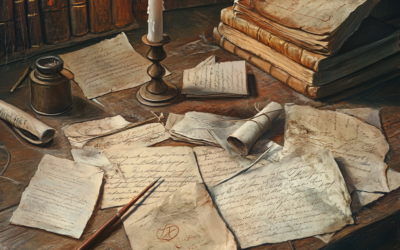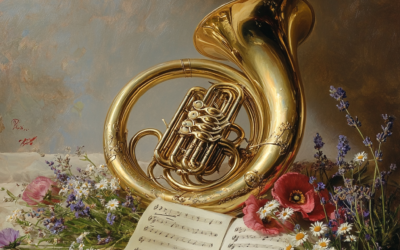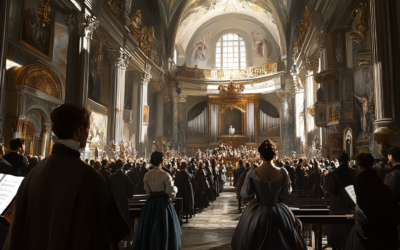The Echo of the Pummerin Bell
And Its Influence on Mozart
The deep, resonant tones of the Pummerin bell in St. Stephen’s Cathedral may have inspired Mozart’s compositions for bass voices, particularly Sarastro in The Magic Flute. As he lived near the cathedral in his final year, the profound sound of the bell might have shaped his musical imagination, infusing his works with a depth that echoes through time.
"Sarastro’s earth-shaking arias... undeniably replicate the sonorous, profound tones of the Pummerin."
H. S. Brockmeyer
The Voice of Vienna
For centuries, the Pummerin bell in St. Stephen’s Cathedral has been the resounding voice of Vienna. With its deep, earth-shaking resonance, this legendary bell has marked the city’s most significant moments, from war to peace, destruction to resurrection. The bell’s rich history spans from its origins in captured Ottoman cannons to its destruction during World War II and eventual recasting. But beyond its historical and symbolic importance, did the Pummerin’s tones find their way into the works of one of Vienna’s most famous composers?
Mozart and the Deep Tones of the Pummerin
Mozart, who lived near St. Stephen’s Cathedral during the final year of his life, would have been intimately familiar with the solemn, booming voice of the Pummerin. H.S. Brockmeyer suggests that the composer may have drawn inspiration from the bell’s immeasurably deep tones when writing for bass singers.
The first potential influence can be seen in The Marriage of Figaro (1786), where the role of Figaro, originally sung by Francesco Benucci, requires a strong, resonant bass. The theme continues in Don Giovanni (1787), where the terrifying Commendatore, portrayed by Giuseppe Lolli in Prague and later Francesco Bussani in Vienna, delivers a chilling bass presence. However, the most striking example comes from The Magic Flute (1791), in which Sarastro’s arias reflect the profound timbre of the Pummerin.
The Living Sound of the Pummerin
Sarastro, the high priest in The Magic Flute, is the ultimate embodiment of authority and wisdom, characteristics that are reinforced by the depth and power of his voice. His arias, “O Isis und Osiris” and “In diesen heil’gen Hallen”, are built upon low, sustained tones that mirror the grave solemnity of the Pummerin bell. This connection is further supported by the fact that Mozart, living at 970 Rauhensteingasse in 1791, was within earshot of the cathedral’s bell, which likely resonated through his daily life.
A Cathedral That Withstood Time and Fire
St. Stephen’s Cathedral has survived centuries of wars and destruction, most notably the catastrophic fire of 1945 that destroyed the original Pummerin. Looters inadvertently set fire to the cathedral’s wooden roof, causing the bell to plummet to the stone floor. A 22-ton bomb further devastated the structure. Despite this tragedy, a second Pummerin was recast using the remnants of the original, preserving its historic essence.
Mozart’s Vienna
H.S. Brockmeyer paints a vivid picture of Mozart’s Vienna, imagining the composer and his wife Constanze on a winter Sunday morning, with the distant tolling of the Pummerin calling the faithful to Mass. Mozart, ever the irreverent spirit, jokes with Constanze before she heads to St. Stephen’s, where the solemn resonance of the bell fills the grand cathedral. This evocative imagery suggests that the Pummerin was more than just a sound in Mozart’s environment—it was an integral part of the city’s sonic fabric, seeping into his consciousness and perhaps influencing his musical language.
A Supernatural Encounter
Brockmeyer recounts an eerie experience in 2010 when, during a late-night walk, she witnessed what appeared to be a ghostly presence emerging from St. Stephen’s Cathedral. The translucent form twisted and floated above the cathedral, prompting her to whimsically address it as “Pummerin.” Could the bell’s spirit still roam the Vienna night, echoing its ancient tones? While this remains a mystery, it underscores the almost mystical connection between the bell, the city, and its musical legacy.
An Echo Through Time
Whether or not Mozart consciously drew inspiration from the Pummerin bell, its deep, resonant tones undeniably parallel the commanding bass lines in his compositions. The bell’s sound, embedded in the daily life of 18th-century Vienna, may have seeped into his musical subconscious, shaping the voices of Figaro, the Commendatore, and most notably, Sarastro.
The Pummerin remains, like Mozart’s music, a symbol of Vienna’s endurance and artistic grandeur. Its reverberations continue to remind us of the city’s past, its destruction and resurrection, and the timeless legacy of those who once walked its streets.
You May Also Like
A Revolutionary Encounter at Cremona Musica
Sharing insights on Mozart and the Neapolitan school at Cremona Musica, the premier global stage for music and culture.
#1 A Man of Cunning
In the end, Leopold Mozart’s life was a testament to survival in a world where his talents were often overshadowed by those of his more gifted contemporaries and his own son. While his “Violinschule” remains a notable contribution to music pedagogy, it is clear that Leopold’s legacy is as much about his ability to navigate the challenges of his time as it is about his musical achievements. His story is one of ambition, adaptation, and the lengths to which one man would go to secure his place in history, even if that place was built on borrowed foundations.
@MozartrazoM
Mozart’s Letters: A Legacy of Disappearances, Edits, and Forgeries
Mozart’s letters reveal missing originals, questionable authorship, and forgeries, adding complexity to his legacy.
The Curious Case of Mozart’s “Lullaby”
Though long credited to Mozart, the lullaby “Schlafe mein Prinzchen, schlaf ein” hides a murky history. Initially published by Nissen, Constanze’s second husband, it has endured as one of Mozart’s supposed works—despite a trail of doubts. In 1798, Constanze herself noted sending “another piece of Mozart’s in place of the lullaby,” raising questions about its origins. By the 20th century, researchers revealed it as the work of lesser-known composers, yet it remains deceptively tied to Mozart, its myth surviving through mere footnotes.
The Contradictions Behind Mozart’s Horn Concerto K.412
The authenticity of Mozart’s Horn Concerto K.412 remains hotly debated, as the work bears numerous contradictions in its manuscript history. The first movement may be original, but what about the rest? The inclusion of Franz Xaver Süssmayr and later editorial meddling raises serious questions about what we are really listening to when we hear this ‘Mozart’ concerto.
The Questionable Attribution of Mozart’s Offertorium K.34
Attributing Offertorium K.34 to Mozart is not just misleading, it reflects the careless methods used by 19th-century scholars to inflate his legacy. Without an autograph or solid evidence, this work should not be considered part of his output.”

